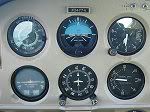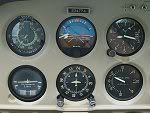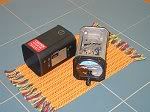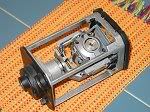Wednesday, May 25, 2005
Yellowbird's Attitude Problem
She's always had it, but I didn't notice it until a flight with Faithful Instructor George last year during which I logged about 45 minutes of simulated instrument time on the way home from Columbia County. It was the first time I had flown Yellowbird under the hood, and to my discredit, it was the first time that I had really paid attention to the instrument cross check. I noticed that with wings level according to the gyroscopic attitude indicator, she would slowly turn to the left. After a few minutes of puzzlement, I began to closely monitor the indications of the attitude indicator, heading indicator, and turn coordinator. I found that the turn coordinator gave me a better indication of wings-level attitude than the attitude indicator did. Sometimes all three instruments would agree, but at times the attitude indicator would appear to sag slightly to one side. It was barely discernible, and at times it appeared to indicate accurately, but my suspicions were aroused. During VFR flights, the variance wasn't critical, and sometimes I wondered if it wasn't merely an optical illusion. The Cardinal windshield is steeply raked, so I sometimes suspected that I was seeing the effect of some visual distortion, but a diligent cross check confirmed that something was amiss. Another disconcerting sign was a slight vibration of the instrument face while in flight it never showed signs of real instability, but I wasn't quite confident in its long-term health.
During VFR flights, the variance wasn't critical, and sometimes I wondered if it wasn't merely an optical illusion. The Cardinal windshield is steeply raked, so I sometimes suspected that I was seeing the effect of some visual distortion, but a diligent cross check confirmed that something was amiss. Another disconcerting sign was a slight vibration of the instrument face while in flight it never showed signs of real instability, but I wasn't quite confident in its long-term health.(Note how the turn coordinator indicates a slight turn to the left, while the attitude indicator shows a slight bank to the right.)
During last year's annual, I had the vacuum pump replaced, but it made no difference. A busy autumn of flying and a very lean winter gave me little time and incentive, respectively, to get her to the shop, but with imminent plans to begin training for my instrument rating, I took advantage of her time in the shop to have the attitude indicator replaced. My mechanic recommended a new Sigma Tek indicator, and since I had heard good things about them, I went along with his recommendation.
 The new indicator proved to be much more reliable. It was rock solid in flight and it agreed nicely with the turn coordinator and heading indicator. It did have two quirks that I hadn't seen in the old instrument. First, as the gyroscope spun up to speed after starting the engine, it would shimmy about for a few seconds before stabilizing. I had observed this on at least one other airplane, and I understand it to be normal behavior. Second, during engine runup prior to takeoff, the instrument face would vibrate noticeably at the runup power setting of 1800 RPM. This had me concerned, as I couldn't imagine that it would be good for the bearings, but no one I asked could offer any recommendations. I logged it among a few other questions I intended to ask of my mechanic the next time I spoke to him, and then forgot it.
The new indicator proved to be much more reliable. It was rock solid in flight and it agreed nicely with the turn coordinator and heading indicator. It did have two quirks that I hadn't seen in the old instrument. First, as the gyroscope spun up to speed after starting the engine, it would shimmy about for a few seconds before stabilizing. I had observed this on at least one other airplane, and I understand it to be normal behavior. Second, during engine runup prior to takeoff, the instrument face would vibrate noticeably at the runup power setting of 1800 RPM. This had me concerned, as I couldn't imagine that it would be good for the bearings, but no one I asked could offer any recommendations. I logged it among a few other questions I intended to ask of my mechanic the next time I spoke to him, and then forgot it.Tuesday dawned gray and dreary, with a low, solid overcast. I was thrilled, since George and I had been waiting for such a day to fly an instrument lesson in actual instrument conditions. After briefing the KBAF VOR 2 approach, we started up and taxied down to the VOR test point in the runup area of runway 2. The VORs centered within a degree of the radial and I ran though the pre-takeoff checklist. We were picking up carburetor ice just sitting on the ramp at 1000 RPM, so I let her run up a little longer than usual with the carburetor heat on to warm things up. During runup, the attitude indicator showed its usual vibration, but while doing a final cockpit check after runup, I noticed that the attitude indicator had fallen. I had a good vacuum indication during runup, but the gyro had assumed the slightly off-kilter position that it normally displays before starting up. George and I sat there for a few minutes pondering this while the gyroscope slowly erected itself again. Sadly, we canceled IFR and taxied back to the tiedown. During taxi, the attitude indicator was erect and stable.
Before parking, I did another runup. Again, I noticed the normal sympathetic vibration, but after about 30 seconds, the gyro began slowly rolling to one side until it had assumed the position observed previously. After reducing power to 100 RPM, the gyro slowly erected again. Today, I did another runup and found that the vibration began at about 1300 RPM and was worst between 1700 and 1900 RPM. Above 1900, the vibration stopped immediately, and the attitude indicator was nice and stable.
I called my mechanic and described the problem, but such things don't generally benefit from long distance diagnoses. She'll have to go back to the shop, but not until the weather clears. Until then, I'm stuck on the ground watching the overcast roll by, no doubt just a few feet above decision height.
 As for the old attitude indicator, it gave good service for thirty years. When pulled out of the panel it rattled with the unmistakable sound of something adrift inside. I decided that $55 was a reasonable price to pay to satisfy my curiosity and gain an unusual paperweight, so I paid my mechanic the core deposit and took it home. Eight screws later, I had it apart and found a small screw and nut rolling around inside the instrument case. It didn't take long to find that they belonged to a counterweight on the gimbals that holds the sealed gyroscope. The counterweight was normally held in place by two screws, but with one missing it sometimes slipped out of place slightly, rolling the whole thing a few degrees to one side.
As for the old attitude indicator, it gave good service for thirty years. When pulled out of the panel it rattled with the unmistakable sound of something adrift inside. I decided that $55 was a reasonable price to pay to satisfy my curiosity and gain an unusual paperweight, so I paid my mechanic the core deposit and took it home. Eight screws later, I had it apart and found a small screw and nut rolling around inside the instrument case. It didn't take long to find that they belonged to a counterweight on the gimbals that holds the sealed gyroscope. The counterweight was normally held in place by two screws, but with one missing it sometimes slipped out of place slightly, rolling the whole thing a few degrees to one side. I replaced the errant screw and put everything back together. I plan on bringing it to work and perching it atop my computer monitor. When my boss tells me that I have a bad attitude, I'll point to my old gyro and cheerfully agree.
I replaced the errant screw and put everything back together. I plan on bringing it to work and perching it atop my computer monitor. When my boss tells me that I have a bad attitude, I'll point to my old gyro and cheerfully agree.